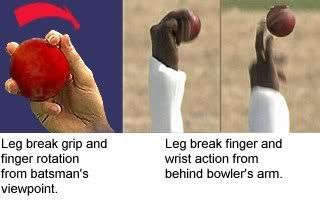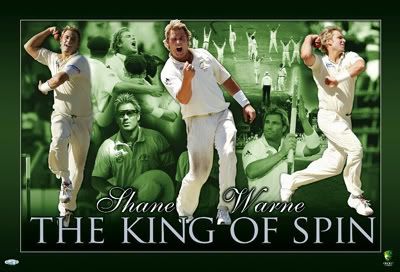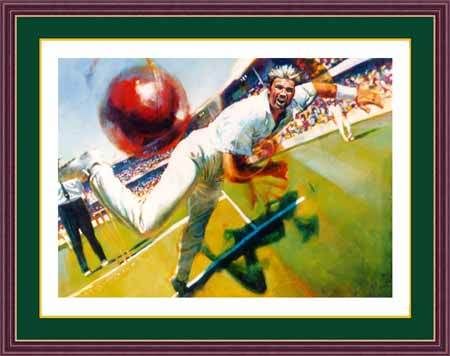1. Swing Bowling Tips For Wicket Taking Success
By Ian Canaway
A bowler who has the ability to bowl swing is an important asset in any cricket team as swing bowling is a great way to baffle a batman, add pressure and take wickets. The swing bowler has the ability to move the ball in the air either away from the batsman or in towards the batsmen. The swing is created by holding the cricket ball in a specific way so that when it is released from the hand the varying levels of air resistance combined with the position the seam is directed causes the ball to swing in the air.
The swing is accentuated by polishing and shining one side of the ball so that is smooth relative to the other side, which should get roughened up through the natural course of play. Select a side to shine at the start of the match and ensure all the bowlers and fielders know which side to polish. You can polish it by rubbing sweat into it and then rubbing it on your cricket trousers.
There are three generally recognised swing delivery types, in swing, out swing and reverse swing.
The out swing delivery is a ball which when bowled by a right handed bowler to a right handed batsman swings from the leg side towards the off side. The aim of the out swinger is to encourage the batsman into playing a drive and ideally the swing will increase the chance of getting an edge and getting the batsmen out caught behind, so make sure you've got some good catchers behind the stumps. You want to pitch the ball quite full, aiming at or just outside off stump so that the batsman is forced to play at the ball.
The grip for the out swing delivery is quite simple and provided the seam is up right at the point of release it should swing. You need to hold the ball as normal for a medium paced delivery with the seam vertical, however for the out swinger the seam needs to be vertical and pointing towards first or second slip at about a 15° angle, so that your fingers will be running slight across the seam. The shiny side should face the leg side of the batsmen, thus the rough side faces the off side and the direction of swing. The increased air resistance on the rough side and seam position will cause it to swing through the air towards the offside. The run up should be slightly angled and bowled from close to the stumps.
The in swing delivery is basically the reverse of the away swing in that when bowled from a right handed bowler it swings in towards a right handed batsmen from the off side towards the leg side. Have a straighter run up and deliver the ball slightly wider on the crease. In contrast to the away swing bowler, the in swing bowler aims to get the batsmen out LBW or bowled by pitching it up. Aim to bowl it so that it swings from outside off stump and pitches in line with middle and off stumps, be careful though because if you start it too straight it will swing down leg side and be easy for the batsman to hit away.
Tip - If you find yourself swinging the ball uncontrollably, hold the ball across the seam so that the seam runs horizontally, this will help negate and reduce the amount of swing.
You need to make sure that your bowlers and fielders are aware of which side of the ball in polished and that is constantly shined between deliveries. Most bowlers will shine the ball themselves but it is always useful to nominate one or two fielders to shine the ball as well while the bowler is walking back to his mark.
Changing weather conditions have an often noticeable affect on the amount that the cricket ball will swing. Dry hot sunny days don't favour swing bowling, whereas overcast, cloudy conditions are found to be most influential at generating more swing. So take this into consideration when deciding who to bowl if you are captain.
Resource Box:
Discover amazing cricket tips and tricks and learn how to play awesome cricket so that you can explode your cricket results and destroy your opposition!
Visit: CricketSecrets.Com
2. Spin Bowling Success Tips
By Ian Canaway
The spin bowler is a key element in the bowling line up of any cricket team, the skill of Shane Warne and Muttiah Muralitharan has highlighted the potential and the shear power and influence a high class spin bowler can have in the game of cricket. The spin bowler can be used to slow the game, add pressure and most importantly attack batsmen. The spin bowler moves the ball off the pitch turning it sideways, as the spinning ball grips the pitch and turns and can also cause it to bounce variably.
A good spin bowler needs to be able to bowl a consistent line and length, is able to turn the ball, which requires lots of practice and dedication to succeed. If you are a spin bowler you should try and experiment with varying degrees of flight, speed, and angle of approach in order to deceive the batsmen.
There are two recognised types of spin bowlers, which are, finger spinners who are classed as the orthodox technique and use their index finger (first finger) to spin the ball and the wrist spinners who use the wrist more than fingers to spin ball.
Target areas:
Off spin: The off spinner aims to spin the ball from a right handed batsmen's off side towards the leg side. Try to bowl just outside of the off stump so that the ball turns and hits the stumps, also try to entice the batsmen forward on to the front foot by bowling a full length.
Leg spin: The leg spinner aims to bowl the ball so that it spins from a right handed batsmen's leg side to the off side. Again try to pitch the ball up to the batsman to get them coming forward. Pitch the ball inline with the wickets so that the ball turns to hit the top of the off stump.
The grip:
Leg spin: Use the first two fingers to grip the ball horizontally across the seam, your third finger should be bent and running along the seam. Your thumb should rest lightly on seam and the spin is generated primarily by the third finger.
Off spin: Again grip the ball with your first two fingers horizontally across the seam and try to spread as wide as possible apart the joints of index and middle finger. The ball then rests lightly on third finger and thumb, the spin is and produced and passed on mainly through the index finger.
The delivery:
The off spin delivery, should start with an angled and short delivery stride. You should then pivot on ball of the front foot keeping your bowling arm high. Cock your wrist inwards and drive your back leg through to help rotate the body. Release the ball by turning your wrist sharply from left to right and by pulling down on seam with the index finger to generate spin. The back of hand should face the off side or upwards at finish of the delivery, don't forget to follow through properly. Keep your head as upright as possible throughout the delivery and your eyes fixed on the target at all times.
The leg spin delivery is very similar to the off spin except with a few subtle and important variations. Your approach should be somewhat longer and have a slightly angled approach towards the target.
As you bowl you should raise your lead arm towards the target and bowl with a braced front leg (your weight should be through this leg). Pivot on the ball of the lead foot and bring your bowling arm up high with your wrist cocked outwards. Drive your back leg through and release the ball. Generate the spin by rotating your wrist from right to left and by most importantly using the third finger to impart the most spin. Finish with your palm facing leg side.
Follow through by rotating shoulders through the line of the wickets and driving your back leg through the action so that your hips rotate over your front foot. Keep your hips and shoulders inline and head as upright as possible throughout the delivery and your eyes fixed on the target at all times.
The Googly and the Doosra: Deceptive deliveries
The googly is bowled by a leg spinner and is a ball that appears to look like a leg spinner when it's bowled but then moves unexpectedly in the opposite direction after it pitches. It's bowled out of the back of the hand and requires the shoulder to be dropped a little at the point of release. A great example of a bowler who has mastered the googly is Shane Warne.
The doosra is bowled by an off spinner and is a ball that initially seems to look like an off spinner when it's bowled but then moves unexpectedly in the opposite direction after it pitches. The doosra has been pioneered by the Sri Lanka great Muttiah Muralitharan and is very difficult to bowl, Muralitharan reputedly practiced the delivery for 2-3 years in the nets and practice before using it in first class cricket…I can't bowl it so I'm not going to go into it!
The power and rotation on the ball are generated through a strong action and is enhanced by flicking the wrist and straightening the fingers at the point of release. Always try and spin the ball as much as you can, your consistency and accuracy will come with practice and hard work. Remember to bowl your spinners with oomph and purpose, don't just throw it up and hope for the best.
Tip- Examine the pitch before bowling and try to identify areas of rough, cracks and other features on the wicket to aim at which may cause increased spin, variable bounce or erratic ball behaviour when pitched on and aim to bowl the ball into these areas provided they don't cause you to bowl bad deliveries (e.g. short and wide).
Resource Box:
Discover amazing cricket tips and tricks and learn how to play awesome cricket so that you can explode your cricket results and destroy your opposition!
Visit: CricketSecrets.Com
3. Wicket Keeping Success Tips
By Ian Canaway
The wicket keeper is an essential and key part of the cricket team. Every team needs a reliable wicket keeper. As well as taking catches, stumping the batsmen and taking run outs, the wicket keeper is one of the team's most important players: motivating and inspiring the bowlers and fielders to raise their game and WIN.
To be a wicket keeper you need fast reactions and precise judgement as you have very little time to react to such things as fast deliveries especially if there are changes and deviations in the balls line due to variations in swing, movement off the pitch and edges.
You need to be alert and have high levels of concentration. Like a top batsmen you want to be able to 'switch on and off' your concentration between deliveries and overs to avoid getting mentally tired, as it's impossible to fully concentrate non-stop for hours at a time. High levels of fitness and flexibility are also very important for a wicket keeper as it can be very tiring because you are effectively doing hundreds of squats and diving around the field. So stay fit, warm up and down and stretch thoroughly to remain in peak condition and avoid injury.
Equipment for wicket keeping
-Wicket keeping gloves (and inner gloves),
-Box,
-Wicket keeping pads,
-Helmet.
Basic technique: Wicket keeping stance
You can stand up to spin bowlers and slower paced bowlers. The wicket keepers stance is quite straight forward, you need to stand about one step behind the stumps, making sure no part of your body or equipment is in front of the line of the stumps.
Crouch down with your left foot (reverse for left hand batsmen) inline with middle stump, therefore on you are crouched a little on off side. Try to keep your head still and eyes level during the delivery to help you judge the pace and line. You should be balanced and relaxed with your weight slightly forward on the balls of your feet. Be alert and ready to react to the delivery.
Catching the ball
When you are catching the ball, aim to get your head/eyes above the line of the ball and your body behind the line of the ball. As the ball rises from the pitch, rise from the crouching position with the ball, so you mirror the height of the ball. Watch the ball into your hands and catch it with your fingers pointing downwards. You'll need to cushion the impact of the ball hitting your gloves when catching by 'giving' with your hands. If the ball continues to rise as it reaches you, step with your outside foot backwards and across, rotating your body outwards, taking the ball on one side of the body. To catch a ball delivered on the off side or leg side, move your feet and body across immediately to get your head back into line with the delivery. (Move the outside foot first and follow with the inside.) Rise with the ball as discussed above and 'give' with hands to reduce the impact.
If you are standing back which you should be to medium and fast bowlers take your stance as discussed above, however stand in a position so that the ball is taken once it begins to drop.
Sometimes you may have to dive to take wide deliveries or thick edges, always try to take the ball in two hands if possible, roll after the dive if you can to reduce the impact of landing and changes of injury.
Stumping
You can attempt a stumping if the batsman is out of the crease after you have caught the delivery. Once you've taken the ball move your body weight towards stumps and move hands fast to break the wickets.
Resource Box:
Discover amazing cricket tips and tricks and learn how to play awesome cricket so that you can explode your cricket results and destroy your opposition!
Visit: CricketSecrets.Com
4. Cricket Batting Tips: The Sweep Shot And Reverse Sweep
By Ian Canaway
The sweep and the reverse sweep are two batting shots which are not commonly used, especially the reverse sweep which is rarely used. However both shots can be used in certain batting situations and are an effective way to score runs and keep the score board ticking over.
There is a high element of risk with the sweep shot, so good judgement and excellent timing is essential. Avoid playing the sweep and reverse sweep early on in your innings especially to straight deliveries, as it is not a good idea to play it until you have your eye in and know how the pitch is playing and what the bowler is doing. As for example, if the ball stayed low it would be quite easy to misjudge and get out LBW or bowled which you definitely want to avoid, so be patient and play yourself in first.
The sweep and reverse sweep are both cross batted shots and should ideally be played to slow deliveries which are of a good length and not too full. To play the orthodox sweep shot, first wait for the ball to be released before making any movement - DON'T PREMEDITATE THE SHOT!
Once you have determined that the ball is there to play the sweep shot to, move your front foot as far down the wicket towards the pitch of the ball as you can. As you are moving forward bend both knees simultaneously so that you whole body is low down, let your back knee touch the ground to act as an extra base of support. Try to stay balanced and relaxed. Bring the bat down from the off side and across the ball towards the leg side and aim to hit it either in front of or behind square leg. You can roll your wrists over the ball as you hit to help keep it on the ground. Aim to have your arms fully extended when you contact the ball.
To play the reverse sweep, get in to the same position as for the orthodox sweep, however this time, bring you bat down and across from leg side towards the off side, so you are aiming to hit the ball through the gully area. This shot requires very good coordination and timing as you have to twist the bat round so that the bat face faces the off side at the point of contact without altering your grip.
Common problems:
-Premeditating the shot- deciding to play the shot before the bowler has bowled the ball. Wait until the ball is released from the bowlers hand before deciding to play the shot.
-Playing the sweep too early in the innings before getting your eye in. Wait until you are set and know how the pitch is playing and what the bowler is doing before attempting the shot.
-Trying to hit the ball too hard. Good timing and technique is better and more effective as you need to reduce the risk as much as possible.
-Playing the shot to deliveries which are either too full or too short, so good judgement of length is required.
Remember that the sweep and reverse sweep are quite hard shots to master and carry quite a lot of risk, so make sure that if you intend to use them, practice the shots in the nets and in training to get a feel for the shot and so you know when to play it; so that when you come to use them you are confident and skilled enough to do so.
Resource Box:
Discover amazing cricket tips and tricks and learn how to play awesome cricket so that you can explode your cricket results and destroy your opposition!
Visit: CricketSecrets.Com
5. Cricket Bowling Tips and Hints
By Ian Canaway
When bowling in cricket there are many possible cricket tips or hints that can help improve your bowling.
In bowling, a combination of natural ability, good technique and practice is the recipe for good bowling, whether it is fast, slow or spin.
Here are some tips that will help your bowling and when implemented correctly your bowling speed:
The basic grip to hold the ball is to keep the seam vertical and to hold the ball with your index finger and middle finger either side of the seam with the side of your thumb resting on the seam underneath the ball.
In your approach/run in, try to stay:
- Smooth,
- Balanced,
- Economical,
- Rhythmical,
- Consistent and stay relaxed and try not to tense up.
During your approach and action, your head position is very important. Make sure that as you approach the wicket you are running at a steady, consistent speed, and increase strides. Aim to keep your head as steady and level as possible, looking towards your target.
Pull your front arm down and through the target area, making sure you complete the delivery with a full follow through.
Try to keep everything in the same direction, towards your target, keep your hips and shoulders parallel/in-line, and follow through the delivery in the direction where you intend the ball to go.
Also as a bowler it is very important to stay in great shape, as you'll enjoy the game more and perform better in the latter stages if you have good stamina. So incorporating some light weight sessions in to your training is important.
Also aim to try and run 3 times a week to keep your cardiovascular system in top condition and to improve your stamina. South African fast bowler Makhaya Ntini, is well know for running 10Km every morning, even on match days!
But make sure you consult your coach/doctor/gym instructor before starting any sessions.
Resource Box:
Discover amazing cricket tips and tricks and learn how to play awesome cricket so that you can explode your cricket results and destroy your opposition!
Visit: CricketSecrets.Com
6. Cricket Batting Tips for Aspiring Batsmen
By Ian Canaway
There are hundreds of different batting tips in the game of cricket which can all potentially improve your batting and run scoring ability. Here is a selection of cricket batting tips that I've found useful to help improve your batting.
-1st Batting Tip - Keep your eyes level, it's been shown that having your eyes level helps speed up your reaction time. It makes it easier for your brain to process the incoming information if your eyes are level when the ball is delivered.
-2nd Batting Tip - Your first movement should be from the shoulders towards the line of the ball. The rest of your body will follow naturally and will help ensure you get correctly inline with the ball.
-3rd Batting Tip - Play the delivery based on its length, if it's short; even if it's in line with the wickets it should be 'tonked away', Andy Flintoff style, to the boundary. The same principle applies with full deliveries and half volleys.
-4th Batting Tip - One of the most important things is to watch the ball from bowlers hand in run up all the way to the bat. By watching the ball in the bowler's hand you can see what the bowler may be trying to do with the ball. Try to identify which is the shiny side or rough side, so you can determine which way they may be trying to swing the ball. The same applies with spinners; but also make sure you closely watch the wrist movement to determine the type and direction of spin.
-5th Batting Tip - When batting against spinners, try doing an initial 'forward press' by making an initial half-step on to the front foot as the bowler bowls. This will give you a good base to play from and help give you quicker feet.
-6th Batting Tip - It is essential to maintain a solid base when batting and to be in a solid position when you play the ball. If you watch, for example Brain Lara play a cover drive, he has a solid base from which he plays the stroke and he is perfectly balanced.
Resource Box:
Discover amazing cricket tips and tricks and learn how to play awesome cricket so that you can explode your cricket results and destroy your opposition!
Visit: CricketSecrets.Com
*Acknowledgemtns to Ian Canaway, CricketSecrets.Com



























